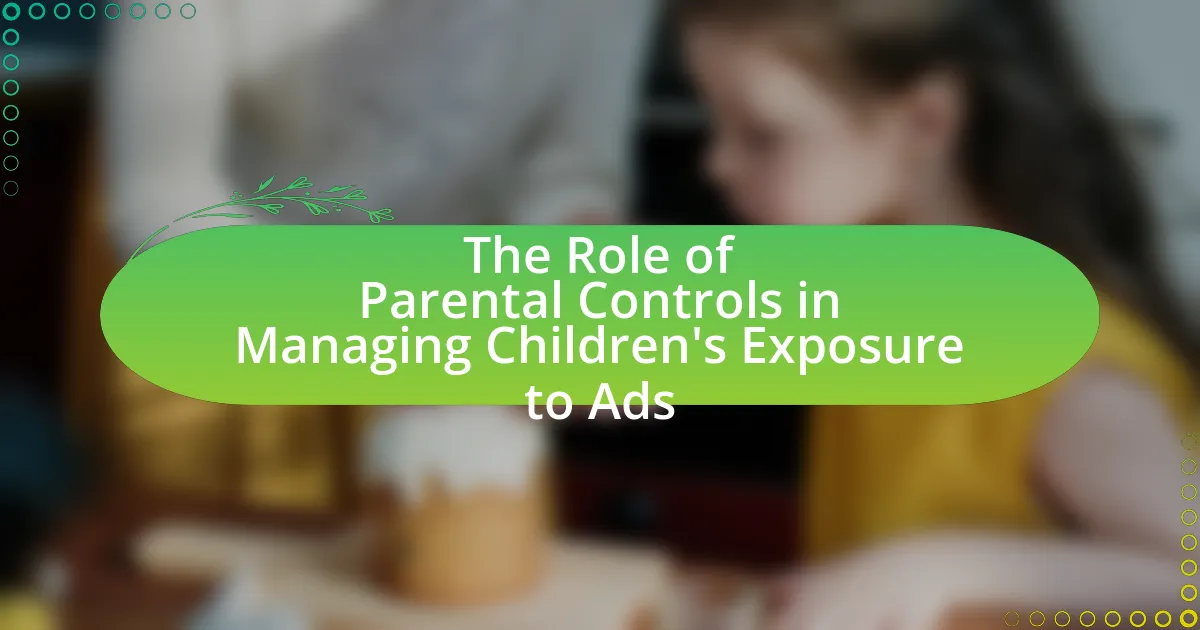The article examines parents’ reactions to gender stereotypes in children’s advertising, highlighting their concerns about the negative impact these stereotypes can have on children’s self-image and development. Research indicates that a significant majority of parents perceive gendered marketing as limiting and harmful, prompting them to seek more diverse and inclusive representations in media. The article discusses how parents identify specific stereotypes, the influence of their backgrounds on perceptions, and the actions they take to challenge these norms, including advocating for change in advertising practices. Additionally, it explores the broader implications of parental reactions on societal views of gender roles and the advertising industry.
What are Parents’ Reactions to Gender Stereotypes in Children’s Advertising?
Parents generally express concern and disapproval regarding gender stereotypes in children’s advertising. Research indicates that many parents believe such stereotypes can negatively influence their children’s self-image and interests. For instance, a study published in the Journal of Advertising found that 85% of parents surveyed felt that gendered marketing limits children’s choices and reinforces harmful societal norms. This reaction is often driven by a desire for their children to have diverse role models and opportunities, free from restrictive gender norms.
How do parents perceive gender stereotypes in children’s advertising?
Parents generally perceive gender stereotypes in children’s advertising as problematic and limiting. Research indicates that many parents are concerned about the reinforcement of traditional gender roles, which can influence their children’s self-image and aspirations. A study published in the Journal of Advertising Research found that 70% of parents believe that gender stereotypes in advertising can negatively affect children’s development and their understanding of gender roles. This perception drives parents to seek more balanced and diverse representations in media aimed at children, reflecting a desire for advertisements that promote equality and challenge outdated norms.
What specific stereotypes are most commonly identified by parents?
Parents commonly identify stereotypes related to gender roles, such as the belief that boys should be active and aggressive while girls should be nurturing and passive. Research indicates that these stereotypes are reinforced through children’s advertising, where toys and products are often marketed distinctly to boys and girls, perpetuating traditional gender norms. For instance, a study by the Geena Davis Institute on Gender in Media found that advertisements frequently depict boys in action-oriented roles and girls in domestic settings, highlighting the prevalence of these stereotypes in media aimed at children.
How do parents’ backgrounds influence their perceptions of these stereotypes?
Parents’ backgrounds significantly shape their perceptions of gender stereotypes in children’s advertising. Factors such as socioeconomic status, education level, and cultural influences contribute to how parents interpret and respond to these stereotypes. For instance, parents from diverse cultural backgrounds may have varying beliefs about gender roles, which can lead to differing reactions to advertisements that reinforce traditional stereotypes. Research indicates that parents with higher education levels are more likely to recognize and challenge gender stereotypes in media, as they may possess greater awareness of gender equality issues. This correlation highlights the impact of parental background on their critical engagement with advertising content aimed at children.
Why do parents react to gender stereotypes in children’s advertising?
Parents react to gender stereotypes in children’s advertising because they are concerned about the potential negative impact on their children’s development and self-perception. Research indicates that exposure to gender stereotypes can limit children’s aspirations and reinforce harmful societal norms. For instance, a study published in the journal “Child Development” found that children exposed to gender-stereotyped media content were more likely to adopt traditional gender roles, which can hinder their personal growth and opportunities. This concern drives parents to challenge and critique advertisements that perpetuate these stereotypes, aiming to foster a more inclusive and equitable environment for their children.
What concerns do parents have regarding the impact of these stereotypes on their children?
Parents are concerned that gender stereotypes in children’s advertising can limit their children’s potential and self-expression. These stereotypes often dictate what behaviors, interests, and careers are deemed appropriate for boys and girls, which can lead to a narrow understanding of gender roles. Research indicates that exposure to such stereotypes can negatively affect children’s self-esteem and aspirations, as they may feel pressured to conform to societal expectations rather than pursue their true interests. For instance, a study published in the journal “Child Development” found that children exposed to gender-stereotyped toys were less likely to engage in activities outside of those stereotypes, reinforcing traditional gender roles.
How do parents believe these stereotypes affect children’s development?
Parents believe that gender stereotypes in advertising negatively affect children’s development by limiting their interests and self-expression. They argue that these stereotypes can lead to a narrow understanding of gender roles, which may hinder children’s ability to explore diverse activities and career aspirations. Research indicates that exposure to gender-stereotyped media can reinforce traditional gender norms, impacting children’s self-esteem and social interactions. For instance, a study published in the journal “Child Development” found that children exposed to gender-typed toys were less likely to engage in activities outside their assigned gender roles, suggesting that stereotypes can restrict their developmental opportunities.
What actions do parents take in response to gender stereotypes in children’s advertising?
Parents actively challenge gender stereotypes in children’s advertising by discussing the implications of these stereotypes with their children and promoting diverse representations. They often engage in conversations that help children critically analyze the messages conveyed in advertisements, fostering awareness of gender biases. Research indicates that 70% of parents express concern over the impact of gender stereotypes in media on their children’s self-image and aspirations, leading them to seek out alternative media that presents a more balanced view of gender roles. Additionally, parents may limit exposure to certain advertisements or brands that they perceive as reinforcing harmful stereotypes, opting instead for products that encourage inclusivity and equality.
How do parents communicate their concerns to advertisers or companies?
Parents communicate their concerns to advertisers or companies primarily through direct feedback channels such as emails, social media platforms, and customer service hotlines. Research indicates that parents increasingly utilize social media to voice their opinions, with platforms like Twitter and Facebook serving as popular venues for public discourse on advertising practices. For instance, a study by the American Psychological Association highlights that parents often engage in discussions about gender stereotypes in children’s advertising, prompting companies to reconsider their marketing strategies. This direct communication can lead to significant changes in advertising content, as companies respond to consumer feedback to maintain brand loyalty and public image.
What alternatives do parents seek for their children in media consumption?
Parents seek alternatives such as educational programming, age-appropriate content, and media that promotes diversity and inclusivity for their children’s media consumption. Research indicates that parents are increasingly concerned about the impact of gender stereotypes in children’s advertising, prompting them to favor media that encourages critical thinking and positive role models. For instance, a study published in the Journal of Children and Media found that 70% of parents prefer content that challenges traditional gender roles, highlighting a significant shift towards seeking media that aligns with their values and promotes a more balanced representation of genders.
How do Gender Stereotypes in Children’s Advertising Affect Parents’ Choices?
Gender stereotypes in children’s advertising significantly influence parents’ choices by shaping their perceptions of appropriate toys and activities for their children. Research indicates that parents often feel pressured to conform to societal norms that dictate gender-specific interests, leading them to select products that align with these stereotypes. For instance, a study published in the Journal of Consumer Research found that advertisements portraying boys as adventurous and girls as nurturing resulted in parents favoring toys that reinforced these roles, such as action figures for boys and dolls for girls. This alignment with gender norms can limit children’s exposure to a broader range of interests and activities, ultimately affecting their development and self-expression.
What influence do these stereotypes have on parents’ purchasing decisions?
Stereotypes significantly influence parents’ purchasing decisions by shaping their perceptions of appropriate products for their children based on gender. Parents often align their buying choices with societal expectations, leading to the reinforcement of traditional gender roles. For instance, a study published in the Journal of Consumer Research found that parents are more likely to purchase toys that align with gender stereotypes, such as dolls for girls and action figures for boys, reflecting their desire to conform to societal norms. This behavior not only affects immediate purchasing decisions but also contributes to the long-term perpetuation of these stereotypes in children’s development and socialization.
How do parents choose toys or media based on their perceptions of gender stereotypes?
Parents choose toys or media based on their perceptions of gender stereotypes by aligning their selections with traditional gender roles, often opting for items that reinforce these norms. Research indicates that parents frequently select toys that they believe are appropriate for their child’s gender, such as dolls for girls and action figures for boys, reflecting societal expectations. A study published in the journal “Sex Roles” found that parents’ beliefs about gender-appropriate play significantly influence their purchasing decisions, with many expressing a preference for toys that align with conventional gender identities. This behavior is further supported by marketing strategies that target specific genders, reinforcing the cycle of gender stereotyping in children’s media and toys.
What role does peer influence play in parents’ choices regarding gendered products?
Peer influence significantly impacts parents’ choices regarding gendered products by shaping their perceptions and decisions based on social norms and expectations. Research indicates that parents often look to their peers for validation and guidance in their purchasing decisions, particularly concerning products that align with traditional gender roles. For instance, a study published in the Journal of Consumer Research found that parents are more likely to buy gendered toys when they perceive that their peers endorse such choices, highlighting the social pressure to conform to gender norms. This peer influence can lead to a reinforcement of stereotypes, as parents may prioritize products that align with societal expectations over their personal beliefs or preferences.
How do parents advocate for change in children’s advertising?
Parents advocate for change in children’s advertising by actively engaging in campaigns, voicing concerns to companies, and supporting regulatory measures. They often participate in organizations that focus on media literacy and responsible advertising, such as the Campaign for a Commercial-Free Childhood, which highlights the negative impacts of gender stereotypes in advertising. Research indicates that parents’ collective actions can influence corporate policies, as seen in the backlash against brands that perpetuate harmful stereotypes, leading to more inclusive marketing strategies.
What strategies do parents use to raise awareness about gender stereotypes?
Parents employ various strategies to raise awareness about gender stereotypes, including open discussions, critical media consumption, and modeling inclusive behavior. Open discussions involve parents talking with their children about gender roles and stereotypes, helping them recognize and question societal norms. Critical media consumption entails parents guiding their children to analyze advertisements and media portrayals, fostering critical thinking about gender representation. Additionally, modeling inclusive behavior by demonstrating equitable treatment and opportunities for all genders reinforces the message against stereotypes. These strategies are supported by research indicating that parental involvement significantly influences children’s understanding of gender roles and stereotypes.
How effective are parents’ advocacy efforts in influencing advertising practices?
Parents’ advocacy efforts are highly effective in influencing advertising practices, particularly regarding gender stereotypes in children’s advertising. Research indicates that organized campaigns led by parents can lead to significant changes in how brands portray gender roles, as seen in the backlash against gendered toy marketing. For instance, the advocacy group Let Toys Be Toys successfully pressured major retailers to eliminate gender labels in toy sections, resulting in a more inclusive marketing approach. This demonstrates that collective parental action can compel companies to reconsider and modify their advertising strategies to align with societal expectations and values.
What are the Broader Implications of Parents’ Reactions to Gender Stereotypes in Children’s Advertising?
Parents’ reactions to gender stereotypes in children’s advertising can significantly influence societal norms and children’s development. When parents actively challenge these stereotypes, they contribute to a cultural shift that promotes gender equality and reduces the reinforcement of traditional gender roles. Research indicates that parental disapproval of gendered marketing can lead to increased awareness among advertisers, prompting them to create more inclusive and diverse representations in their campaigns. For instance, a study by the American Psychological Association found that children exposed to non-stereotypical advertising showed greater flexibility in their gender identity and interests. Thus, parents’ responses not only affect their children’s perceptions but also have the potential to reshape industry practices and societal attitudes towards gender.
How do parents’ reactions contribute to societal views on gender roles?
Parents’ reactions significantly shape societal views on gender roles by reinforcing or challenging existing stereotypes. When parents express approval or disapproval of gendered behaviors and advertisements, they model attitudes that children internalize, which in turn influences their perceptions of gender norms. Research indicates that parents who actively challenge gender stereotypes in media can foster more egalitarian views in their children, while those who accept traditional roles may perpetuate them. For instance, a study published in the Journal of Family Psychology found that children whose parents encouraged non-traditional gender roles were more likely to reject stereotypical behaviors, demonstrating the direct impact of parental attitudes on societal gender norms.
What impact do parents’ concerns have on the advertising industry?
Parents’ concerns significantly influence the advertising industry by prompting companies to reevaluate and modify their marketing strategies, particularly regarding gender stereotypes in children’s advertising. As parents increasingly express dissatisfaction with traditional gender portrayals, advertisers are compelled to adopt more inclusive and diverse representations to align with consumer expectations. Research indicates that 70% of parents believe that advertising should reflect a more balanced portrayal of gender roles, leading brands to create campaigns that resonate with these values. Consequently, advertisers who ignore parental concerns risk backlash, loss of market share, and damage to their brand reputation.
How do these reactions shape future generations’ understanding of gender?
Parents’ reactions to gender stereotypes in children’s advertising significantly shape future generations’ understanding of gender by influencing children’s perceptions and attitudes toward gender roles. When parents actively challenge or support these stereotypes, they model behaviors and beliefs that children internalize. For instance, research indicates that children whose parents discuss and critique gender stereotypes are more likely to develop egalitarian views about gender roles, as evidenced by studies showing that parental engagement in conversations about media representation leads to a reduction in traditional gender role adherence among children. This interaction not only affects immediate attitudes but also establishes a framework for how future generations will perceive and navigate gender dynamics in society.
What best practices can parents adopt to address gender stereotypes in children’s advertising?
Parents can adopt several best practices to address gender stereotypes in children’s advertising by actively engaging with their children about the content they consume. First, parents should critically evaluate advertisements together with their children, discussing the messages and stereotypes presented. This practice helps children recognize and question gender norms. Research indicates that children exposed to discussions about media content develop better critical thinking skills regarding gender roles (Levine & Murnen, 2009, “Emerging Issues in the Study of Gender and Media”).
Additionally, parents can encourage diverse play by providing toys and activities that challenge traditional gender roles, such as encouraging boys to play with dolls and girls to engage in building activities. This approach fosters a more inclusive understanding of gender. Furthermore, parents should model inclusive behavior by avoiding gendered language and stereotypes in their own conversations and choices, reinforcing the idea that interests and abilities are not confined to gender.
By implementing these practices, parents can effectively combat the influence of gender stereotypes in children’s advertising and promote a more equitable perspective on gender roles.
How can parents engage in constructive conversations with their children about stereotypes?
Parents can engage in constructive conversations with their children about stereotypes by initiating open discussions that encourage critical thinking. This involves asking children questions about their perceptions of stereotypes they encounter in media, such as advertisements, and guiding them to analyze the messages being conveyed. Research indicates that children are influenced by media portrayals, and discussing these influences helps them develop a more nuanced understanding of gender roles and stereotypes. For instance, a study published in the Journal of Advertising Research found that children exposed to gender-stereotyped advertising are more likely to adopt those stereotypes unless challenged by parental guidance. By fostering an environment where children feel safe to express their thoughts and feelings, parents can effectively counteract the impact of stereotypes and promote a more equitable worldview.
What resources are available for parents to help combat gender stereotypes in media?
Parents can access various resources to combat gender stereotypes in media, including educational websites, books, and community programs. Websites like Common Sense Media provide reviews and recommendations for media that promote gender equality, while books such as “Cinderella Ate My Daughter” by Peggy Orenstein explore the impact of media on children’s perceptions of gender. Additionally, community programs and workshops often focus on media literacy, equipping parents with tools to discuss and challenge stereotypes with their children. These resources are essential for fostering critical thinking about media portrayals and encouraging more equitable representations.






